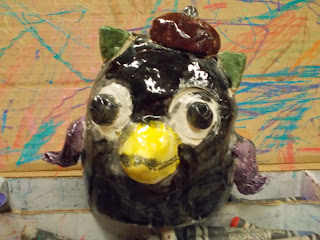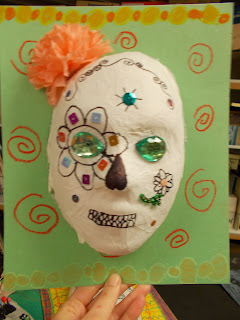"Mama"

"Mama" by my daughter age 3
Friday, December 20, 2013
Worm's Eye Perspective Snowmen
5th graders
learned about worm’s eye perspective in art class. Worm’s eye perspective is
looking up at an object, like if you were a worm looking up at a very tall
snowman. They outlined their drawings in Sharpie and colored in with construction
paper crayons. Quick, easy, and very cute!
Angry Bird Soft Sculptures and Drawings
5th graders learned about the artist Claes Oldenburg through a Power Point presentation. Since 1962, Oldenburg has been making soft sculpture based on common objects ranging from household fixtures (such as toilets, fans, and light switches) to even food. Students also reviewed the art movement, POP ART. Pop art can be any every day item, also. Pop Art is short for Popular Art. It is inspired by comic strips, advertising, and popular entertainment…things that you would see in everyday life.
When deciding what students should create for their soft sculptures, I looked to what’s popular in their culture right now- ANGRY BIRDS! Students first created an Angry Bird drawing, they had a choice of 3 templates to trace, but were responsible for adding all the details in the face and body. They outlined in Sharpie, colored in, and cut it out. This would later be used as a guide for when they were adding details to their soft sculptures.
For their sculptures students used their drawing as a tracer, and traced it onto two pieces of felt, then cut it out. Students learned how to sew using two types of stitches in their sculpture- a straight stitch and a whip stitch. When their sculpture was about ¾ of the way sewn shut, they stuffed it with cotton batting to make their sculptures fluffy, like Oldenburg’s sculptures.
Gingerbread prints
2nd and 3rd graders learned about the art technique of printmaking. Printmaking is the process of making art by printing on paper using a printing block or plate. Students first drew a gingerbread person and then traced it onto a Styrofoam printing plate. Next students brushed brown paint onto their printing plate making sure to apply it evenly. Then they carefully placed their printing plate onto their colored background, and then used a printing brayer (roller) to transfer the image. Printmaking can be tricky because you have to make sure to apply the paint evenly, not move the plate while transferring your print, and carefully removing your printing plate to get a clean print. The students created four prints in their gingerbread series, so they got lots of practice using this technique. Sometimes art can be more about the process of art making rather than the final product. Students jazzed up the prints that didn’t come out so clearly by outlining in glue and glitter and adding candy canes and snow. They did a great job for their first time at printmaking!
Tuesday, December 3, 2013
Aerial Perspective Snowmen
2nd graders read the story Snowmen At Night. They drew snowflakes with white crayon on
white paper to create a wax resist when painted over with blue water color.
Students then learned what aerial perspective is. Aerial perspective, or bird’s
eye view, is when you are viewing something from above. They cut out three
different sized circles and outlined them in blue oil pastel. Instead of
stacking the snowmen slightly overlapping one another, 2nd graders
stacked and glued them one right on top of the other to create an aerial
perspective. They added a scarf, face, and arms.
Super Hero Self Portraits
2nd
graders learned how to draw a self- portrait. They paid close attention to
putting the facial features in the correct spot on the face, and creating a
proper hairline. They also learned what an onomatopoeia is. An onomatopoeia is the use of words such as buzz or murmur
that imitate the sounds associated with the objects or actions they refer to.
Kandinsky Color Mixing
1st graders studied the artist Wassily Kandinsky and
abstract art. They learned that abstract art doesn’t show a person, place, or
thing; but rather includes lines, shapes, and colors and can be interrupted
differently by anyone who views it.
They also learned about the secondary colors: green,
orange, and purple. They did a color mixing worksheet where they discovered
when certain primary colors are mixed together they then create the secondary
colors.
Students stamped overlapping circles on their papers.
In the areas that were not overlapping they colored in using the primary
colors. The areas that were overlapping
they colored in a secondary color, looking at which two primary colors were
overlapping to figure out the secondary.
Colored Pencil Owls
4th graders learned:
several facts about owl
how to draw an owl by looking at different types of owls.
used construction paper color pencils to color in owls.
used a new coloring technique called hatching to color in owls.
Skeleton Masks
Day
of the Dead
(Spanish: Día de los Muertos) is a holiday celebrated by many in Mexico and
by some Mexican Americans living in the United States. The holiday focuses on
gatherings of family and friends to pray for and remember friends and family
members who have died. Traditions connected with the holiday include building
private altars honoring the deceased using sugar skulls, marigolds, and the
favorite foods and beverages of the departed and visiting graves with these as
gifts. The Day of the Dead is a time of celebration when eating and partying
are common.
Fifth
graders learned about the Mexican holiday, Day of the Dead through a short
videos and a classroom discussion. First the students created a paper mache
mask using a face mold. Once dried, students looked at different Dia de los
Muertos skeleton for inspiration for their drawing details. They then used
gemstones, sequins, beads, and flowers to decorate. They turned out awesome!
Dancing Skeletons
El Dia de los Muertos (DAY OF THE
DEAD) is a tradition that has been celebrated in Mexico for over 500 years. It
is celebrated on November 1st and 2nd. This is a time to remember and honor
loved ones who have passed away. It is not supposed to be sad or scary; it’s a
time to celebrate life itself. In Mexico on these two days people create altars
that are filled with food, photographs, candles, skulls, flowers, etc. to
remember all the great memories from those who have passed away. Some Mexicans
decorate and set up altars at the grave sites as well. The calavera, or
skeleton is an important symbol during Dia del los Muertos. On these two
special days there are many types of toys, food, masks and miniatures made to
look like skulls or skeletons. Students were able to create skeleton from scrap
white paper on a background they colored in using construction paper crayons.
Subscribe to:
Comments (Atom)

















































